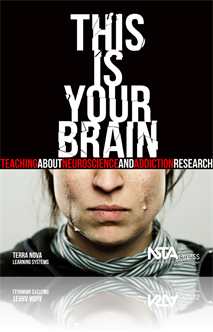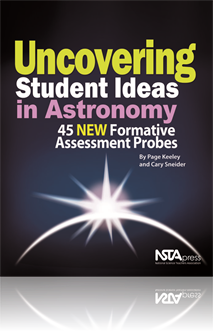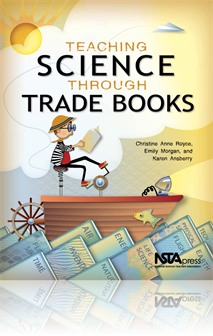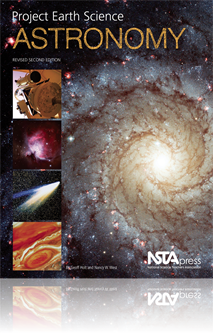All Book Chapters
Book Chapter
This chapter contains the unit test and answer key as well as the essay question assessment Rubric for the book This is Your Brain. Other alternate assessment options are also included. ...
Book Chapter
This chapter contains supporting materials such as a Student Glossary, Parent/Guardian letter, resources for teachers, parents, and students for the book This is Your Brain....
Book Chapter
In this activity, students will be able to describe the role decomposers play in an ecosystem and learn to identify organisms that live on the forest floor, in the leaf litter and underground....
Book Chapter
The purpose of this assessment probe is to elicit students’ ideas about gravity. The probe is designed to see if students recognize that gravity exists everywhere in space, not just on Earth....
Book Chapter
The purpose of this assessment probe is to elicit students’ ideas about the size of the Moon. The probe is designed to find out if students understand the idea that something huge can appear to be small if we see it from a great distance, and and t...
Book Chapter
Does the Moon Orbit the Earth?
The purpose of this assessment probe is to elicit students’ ideas about the Moon’s motion. The probe is designed to find out whether students recognize that the Moon orbits the Earth, and, if so, how long they think it takes to complete one orbit...
Book Chapter
The purpose of this assessment probe is to elicit students’ ideas about sunspots. The probe is designed to determine if students are aware of a prominent feature of the Sun that they can observe under safe conditions—sunspots—and if they know w...
Book Chapter
The purpose of this assessment probe is to elicit students’ ideas about the day-night cycle. The probe is designed to find out if students can relate the shape of the Earth and its spin to why we have day and night. ...
Book Chapter
The purpose of this assessment probe is to elicit students’ ideas about Earth’s orbit. The probe is designed to find out whether students recognize that the Earth orbits around the Sun. ...
Book Chapter
As a thesaurus of science concepts, The Everyday Science Sourcebook, Revised 2nd Edition: Ideas for Teaching in Elementary and Middle School provides easy access to science activities that teach science concepts that correspond to national standards....
Book Chapter
As you begin your science teaching career, you will have many questions. The best place to start is to ask questions of yourself. You may not be able to answer all of the questions quickly or casually, but they should be food for thought. Spend time ...
Book Chapter
Although teachers have a huge influence on students, no one can have the effect on students that parents can. No matter the student’s age, the approval of parents is a fundamental need of every child and a powerful motivator. Parents can support yo...
Book Chapter
Consider observations by others as opportunities to improve your skills as a teacher. Be proactive in providing your observer with as much information as possible to make their visit productive. Informed comments from an observer can help you identif...
Book Chapter
Even the most competent, professional teacher in the school was once a first-year teacher and faced issues similar to yours. Many of your colleagues will be sympathetic to your struggles and willing to help. Take advantage of their expertise and expe...
Book Chapter
End-Of-Year Activities And Reflections
By spending a little time at the end of the year organizing your materials and reflecting on your experiences as discussed in this chapter, you’ll be ready for the challenges at the beginning of the next year. ...
Book Chapter
Before You Open The Classroom Or Lab Door For Students
No one is going to tell you what to do during the most critical day of school—the first day. You are responsible for creating the atmosphere and tone that your classroom will provide for the entire year and beyond. The expectations, routines, and p...
Book Chapter
. The way you begin the school year will affect everything that occurs in your classroom and with your colleagues for the remainder of the year—and beyond. When you were student teaching, your cooperating teacher had already set the stage for you. ...
Book Chapter
Creating An Environment For Learning
Think of your classroom as an ecosystem—a set of interconnected components such as the classroom itself, the available resources, and the people who inhabit it. When these components are working well together, learning can be a joyous, exciting adv...
Book Chapter
When you were student teaching or doing an internship, your cooperating teacher already had lab routines and rules in place. But now you’re in charge! You must be proactive about student safety during laboratory activities. You can’t claim ignora...
Book Chapter
When you see a purpose in what you do, feel confident, and like what you do, it shows. Students are among those who can immediately read others. They will know if you are eager to get to school each day, if you enjoy what you teach, and if you care a...
Book Chapter
As a teacher, you can threaten, cajole, plead, or reward students into doing what you want, but the ultimate decision about how much to participate is made by the students. This chapter gives many suggestions of new strategies to try to help your stu...
Book Chapter
Student learning is the ultimate goal of everything you do in the classroom. Assessment is the process of gathering information (or evidence) from a variety of sources to determine what students are learning in terms of knowledge and skills and how t...
Book Chapter
Creating Professional Development Opportunities
Even if your school does not require one, it’s important for you to have your own plan for continuing education. You can begin by generating a list of what you want to learn. Perhaps it is science-related content, or maybe it’s a teaching strateg...
Book Chapter
When students think of cold weather, they often think of mittens, snowflakes, and penguins! In this chapter, celebrate those tuxedo-clad birds that have come to symbolize winter and provides students with the opportunity to investigate adaptations th...
Book Chapter
Earth is an extremely complex system with many components and subsystems, and they all interact and affect each other. The four major subsystems are atmosphere (air), lithosphere (land), hydrosphere (water), and biosphere (life). A change in one part...
Book Chapter
Global warming is happening now, and scientists have evidence that humans are to blame. The rate of warming in the past 50 years has doubled, and temperatures are certain to go up even more. To gain an understanding of how global warming might impact...
Book Chapter
Resurrection Plant: Making Science Come Alive!
An inanimate, seemingly dead, 3–5 in. ball-shape brown object placed in water and exposed to sunlight is observed to “come back alive” and turn into a vibrant green photosynthetic plant over a period of anywhere from several hours to one day...
Book Chapter
Toothbrush Design—Is There A Better Bristle?
What kind of toothbrush do you use—manual or electric? What is the shape of the head and the handle? Could you describe the firmness and the layout of the bristles? Or count the number of bristles? In this 5E Model lesson, students explore various ...
Book Chapter
Historical Use of Trade Books in the Science Classroom
“Teaching Through Trade Books” is a column that has appeared monthly in Science and Children since January 2003. It highlights the science and literacy connections that can be made with children’s literature and provides readers with “novel�...
Book Chapter
In today’s electronic age of video games and MP3 players, children are not spending as much time outdoors as past generations did. Many fear that as a result children are becoming increasingly alienated from the natural world. The lessons in this c...
Book Chapter
We often gloss over the history of science—the women and men who have made advancements in the area of scientific discovery. These notable individuals are the backbone of our field. In the activities, in the chapter, the authors honor these scienti...
Book Chapter
Your students are most likely not knowledgeable about the raw materials, the design processes, and the technology involved in manufacturing the products they use everyday. Making connections with local manufacturers can connect students to the real s...
Book Chapter
“Is it time yet?” is a cry heard from many a student’s mouth. Is it time for lunch? Is it time to go home? Is it time for recess? Is it time for science? (we can always hope)… and the list can go on and on. Students often equate time with an ...
Book Chapter
From the youngest ages children construct buildings, bridges, towers, and anything else that comes to mind using a variety of materials. The books and activities, in this chapter, take this interest in construction and build on it by allowing student...
Book Chapter
The lessons in this chapter challenge students' common misconception that air is "nothing." Using two engaging trade books with "stop-and-try-it" formats, students participate in activities, collect evidence, and develop explanations to prove that ai...
Book Chapter
What goes up mush come down … as long as you aren’t floating in space, that is! So let’s explore the concepts of gravity. In this chapter, the lesson for grades K–2, through several activities and readings, students learn that the force of gr...
Book Chapter
Students of all ages are fascinated by the ups, downs, loops, and twists of roller coaster rides! What they may not realize is that there is a lot of science involved in making a roller coaster work. This chapter puts students in the shoes of a rolle...
Book Chapter
Why Use Trade Books to Teach Science?
One of the most compelling reasons to use picture books to each science concepts is that picture books are highly engaging to students of all ages. This chapter describes what exactly is a trade book as well as some of the benefits of using trade boo...
Book Chapter
The date was December 17, 1903. The place was a windswept beach near Kitty Hawk, North Carolina. With Orville Wright at the controls and his brother Wilbur running alongside, the plane took off. This event lasted only 12 seconds, but it made history ...
Book Chapter
When students flick on lights, boot up a computer, or turn on a television, do they think about how that energy is produced? The majority of electricity in the United States is generated from power plants that burn fossil fuels, causing large amounts...











